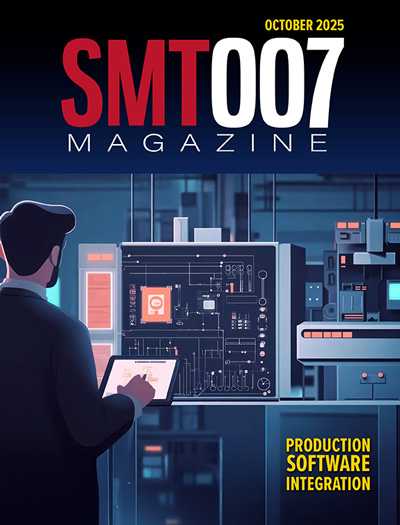-

- News
- Books
Featured Books
- smt007 Magazine
Latest Issues
Current Issue
Production Software Integration
EMS companies need advanced software systems to thrive and compete. But these systems require significant effort to integrate and deploy. What is the reality, and how can we make it easier for everyone?

Spotlight on India
We invite you on a virtual tour of India’s thriving ecosystem, guided by the Global Electronics Association’s India office staff, who share their insights into the region’s growth and opportunities.

Supply Chain Strategies
A successful brand is built on strong customer relationships—anchored by a well-orchestrated supply chain at its core. This month, we look at how managing your supply chain directly influences customer perception.
- Articles
- Columns
- Links
- Media kit
||| MENU - smt007 Magazine
Practical Verification of Void Reduction Method for BTC Using Exposed Via-in-pad
December 16, 2019 | Alfredo Garcia, et al, Sanmina and NokiaEstimated reading time: 1 minute
Abstract
Void reduction strategies used with different levels of success throughout the industry include managing reflow profile parameters, solder paste deposit volume and solder paste type, stencil aperture cut to different geometries, thermal pad geometries with and without solder mask webs, vacuum-assisted reflow, sweep stimulation of PCB substrate, use of solder preforms, tinning of the components pads before placement and reflow, I/O aperture design to overprint at the toe of the pad, and exposed via-in-pad [1–8]. The translation of these methods and their combinations for void control on the thermal pad of bottom-terminated components (BTCs) has been met with different levels of success in volume production.
The method explored in this article regards the use of exposed via-in-pad. A dedicated test vehicle was designed for two types of QFN components. The main variables accounted for were the component size, number of exposed vias in the thermal pad, via pitch, via size, and solder paste coverage. The responses sought in this experiment include a thermal pad void level and solder wicking down the via barrel with resulting solder protrusion on the opposite side of the PCB.
The results indicated that solder will wick down the exposed via-in-pad regardless of the via diameter and solder paste coverage. Despite this finding, there were no defects recorded like component tilting, skewing, opens, or solder bridging. Specific configurations attained voiding levels in the thermal pad below 25%; however, other configurations did show a void level for the thermal pad up to 50%. A discussion will be presented regarding the effect of the board thickness and the geometry of the via array on the thermal pad solder coverage and voiding level.
To read this entire article, which appeared in the November 2019 issue of SMT007 Magazine, click here.
Testimonial
"In a year when every marketing dollar mattered, I chose to keep I-Connect007 in our 2025 plan. Their commitment to high-quality, insightful content aligns with Koh Young’s values and helps readers navigate a changing industry. "
Brent Fischthal - Koh YoungSuggested Items
Rehm Wins Mexico Technology Award for CondensoXLine with Formic Acid
10/17/2025 | Rehm Thermal SystemsModern electronics manufacturing requires technologies with high reliability. By using formic acid in convection, condensation, and contact soldering, Rehm Thermal Systems’ equipment ensures reliable, void-free solder joints — even when using flux-free solder pastes.
Indium Experts to Deliver Technical Presentations at SMTA International
10/14/2025 | Indium CorporationAs one of the leading materials providers to the power electronics assembly industry, Indium Corporation experts will share their technical insight on a wide range of innovative solder solutions at SMTA International (SMTAI), to be held October 19-23 in Rosemont, Illinois.
Knocking Down the Bone Pile: Revamp Your Components with BGA Reballing
10/14/2025 | Nash Bell -- Column: Knocking Down the Bone PileBall grid array (BGA) components evolved from pin grid array (PGA) devices, carrying over many of the same electrical benefits while introducing a more compact and efficient interconnect format. Instead of discrete leads, BGAs rely on solder balls on the underside of the package to connect to the PCB. In some advanced designs, solder balls are on both the PCB and the BGA package. In stacked configurations, such as package-on-package (PoP), these solder balls also interconnect multiple packages, enabling higher functionality in a smaller footprint.
Indium to Showcase High-Reliability Solder and Flux-Cored Wire Solutions at SMTA International
10/09/2025 | Indium CorporationAs one of the leading materials providers in the electronics industry, Indium Corporation® will feature its innovative, high-reliability solder and flux-cored wire products at SMTA International (SMTAI), to be held October 19-23 in Rosemont, Illinois.
‘Create your Connections’ – Rehm at productronica 2025 in Munich
10/08/2025 | Rehm Thermal SystemsThe electronics industry is undergoing dynamic transformation: smart production lines, sustainability, artificial intelligence, and sensor technologies dominate current discussions.


